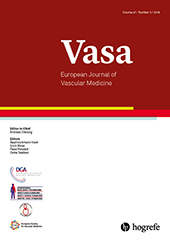Development and validation of the Patient Benefit Index for peripheral arterial disease
Abstract
Abstract.Background: The aim of this study was to develop and validate a specific Patient Benefit Index (PBI) version for the treatment of peripheral arterial disease (PAD). Patients and methods: A non-interventional longitudinal development study was conducted. The first phase comprised a qualitative pre-study with n = 50 patients, in which the PBI was adapted for peripheral arterial disease. The resulting Patient Benefit Index for peripheral arterial disease (PBI-PAD) was validated in the second phase at two points of measurement. The total PBI-PAD score was calculated by weighting item-wise the achievement of treatment goals with the initially assessed needs. Feasibility, internal consistency, and construct validity were analysed and the generic three level version of the EuroQol five-dimensional questionnaire (EQ-5D-3L) and the disease-specific instrument Vascular Quality of Life Questionnaire (VascuQoL) were used for convergent validation. Results: In the pre-study, the PBI-PAD, consisting of 12 items, was developed. N = 103 patients participated in the main study. At T2, data were available for n = 57 patients. Mean age was 71.0 years ± 9.1 and 66.7 % of the participants were male. The amount of missing values of the PBI-PAD score was low (< 4.0 %) and no relevant floor effects were observed. Both parts of the PBI (needs at T1 and benefits at T2) were internally consistent with Cronbach’s alpha > 0.7. PBI-PAD total score correlated significantly with the T2-T1-differences of the EuroQol-visual analogue scale (EQ VAS) (r = 0.4, p = 0.007) and the Vascular Quality of Life Questionnaire (r = 0.5, p < 0.001). Conclusions: The PBI-PAD is a feasible, internally consistent, and valid instrument to assess patient-relevant benefits in PAD patients receiving minimally invasive treatment or surgical procedures. It can be recommended for use in routine care as well as in clinical studies.
Literature
. Lebensqualität als Ergebnisparameter in gesundheitsökonomischen Studien. In: Schöffski O, editor. Gesundheitsökonomische Evaluationen. 3rd ed. Berlin: Springer; 2008. 321–34.
. Quality of Life – The assessment, analysis and reporting of patient-reported outcomes. 3rd ed. Chichester, West Sussex: Wiley Blackwell; 2016.
A call to action: women and peripheral artery disease: a scientific statement from the American Heart Association. Circulation. 2012;125:1449–72.
. Prevalence of and risk factors for peripheral arterial disease in the United States: results from the National Health and Nutrition Examination Survey, 1999–2000. Circulation. 2004;110:738–43.
. Quality of life associated with varying degrees of chronic lower limb ischaemia: comparison with a healthy sample. Eur J Vasc Endovasc Surg. 1999;17:319–25.
. Quality of life and objective disease criteria in patients with intermittent claudication in general practice. Fam Pract. 2003;20:36–40.
. Quality of life assessment in vascular disease: towards a consensus. Eur J Vasc Endovasc Surg. 1997;13:9–13.
Comparison of generic and disease-specific questionnaires for the assessment of quality of life in patients with peripheral arterial disease. J Vasc Surg. 2005;41:261–8.
. Assessing the validity and responsiveness of disease-specific quality of life instruments in intermittent claudication. Eur J Vasc Endovasc Surg. 2006;31:46–52.
. Test-retest reliability and measurement error are excellent for the dutch version of the VascuQol questionnaire in patients with intermittent claudication. Eur J Vasc Endovasc Surg. 2015;50:502–5.
. Developing the Vascular Quality of Life Questionnaire: a new disease-specific quality of life measure for use in lower limb ischemia. J Vasc Surg. 2001;33:679–87.
The effects of exercise training on walking function and perception of health status in elderly patients with peripheral arterial occlusive disease. J Intern Med. 2002;252:448–55.
. Prospective, systematic observational study on the daily use of Cilostazol (Pletal) in clinical vascular surgical practice – significant improvement of walking distance and quality of life for patients with PAOD, stage II b. Zentralbl Chir. 2015;140:440–8.
. Padma 28 – a useful supplement in the treatment of peripheral arterial occlusive disease in the stages IIa and IIb. Forsch Komplementmed. 2013;20(Suppl 2):22–4.
The patient benefit index: a novel approach in patient-defined outcomes measurement for skin diseases. Arch Dermatol Res. 2009;301:561–71.
. Measuring change in quality of life: bias in prospective and retrospective evaluation. Value Health. 2015;18:110–5.
. Measuring patient-relevant benefits in pruritus treatment: development and validation of a specific outcomes tool. Br J Dermatol. 2009;161:1143–8.
A new instrument for the assessment of patient-defined benefit in the treatment of allergic rhinitis. Allergy. 2011;66:665–70.
Benefit evaluation in the therapy of chronic wounds from the patients’ perspective – development and validation of a new method. Wound Repair Regen. 2012;20:8–14.
Evaluation of patient-relevant outcomes of lymphedema and lipedema treatment: development and validation of a new benefit tool. Eur J Vasc Endovasc Surg. 2014;47:100–7.
Quality of life and patient benefit following transition from methotrexate to ustekinumab in psoriasis. J Eur Acad Dermatol Venereol. 2017;31:294–303.
. Surgical treatment of peripheral circulation disorders. Helv Chir Acta. 1954;21:499–533.
. EuroQol – a new facility for the measurement of health-related quality of life. Health Policy. 1990;16:199–208.
. German version of the EuroQol questionnaire. Z Gesundh Wiss. 1998;11:3–20.
. Development and validation of a new instrument for the assessment of patient-defined benefit in the treatment of acne. J Dtsch Dermatol Ges. 2008;6:113–20.
. Scale development: Theory and applications. 2nd ed. Thousand Oaks, California: Sage Publications; 2009.
. The clinical significance of adaptation to changing health: a meta-analysis of response shift. Qual Life Res. 2006;15:1533–50.
. Factor analysis: An applied approach. Hillsdale, New Jersey: Lawrence Erlbaum Associates; 1983.
. Outpatient rehabilitation in patients with coronary artery and peripheral arterial occlusive disease. Arch Phys Med Rehabil. 2008;89:618–21.



